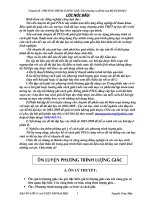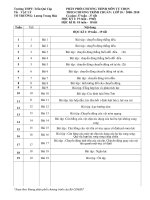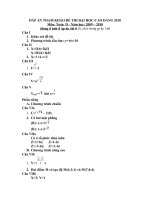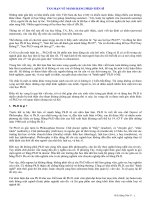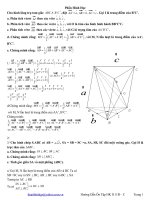P t judith hanson lasater ph d , ike k lasater what we say matters practicing nonviolent communication rodmell press (2009) tủ tài liệu training
Bạn đang xem bản rút gọn của tài liệu. Xem và tải ngay bản đầy đủ của tài liệu tại đây (710.55 KB, 177 trang )
yoga / communication / relationships
$14.95
extend empathy to yourself and others
distinguish between feelings and needs
▶ make requests rather than demands
▶ choose connection over conflict
▶ create mutually satisfying outcomes
▶
▶
ISBN-13:
978-1-930485-24-2
ISBN 978-1-930485-24-2
www.rodmellpress.com
distributed by publisher s Group west
Judith & Ike Lasater
Have you ever tried to tell someone what you want only to feel misunderstood and frustrated? Or hesitated to ask for what you
needed because you didn’t want to burden the other person? Or
been stuck in blame or anger that wouldn’t go away?
Judith and Ike Lasater, long-term students of yoga and Buddhism,
experienced dilemmas like these too. Even though they had studied
the yoga principle of satya (truth) and the Buddhist precept of right
speech, it was not until they began practicing Marshall Rosenberg’s
techniques of Nonviolent Communication (NVC) that they understood how to live satya and right speech.
In What We Say Matters, Judith and Ike describe their journey
through NVC and how speech becomes a spiritual practice based
on giving and receiving with compassion—everywhere, all the
time—whether at home, at work, or in the world. Their writing is
deeply personal, punctuated by their recounts of trial and error, success and failure, laughter and challenge—even in writing this book!
They guide you through an introduction to NVC with clear explanations, poignant examples, suggested exercises, and helpful
resources. With practice you’ll learn new ways to:
What We Say Matters
Yoga teacher Judith Hanson Lasater
and mediator Ike K. Lasater
live in the San Francisco Bay Area.
Com
Ch mun
Sel oices ica
Yo f Lea Feelin
Re ga Ri rning
Ch quest ght Sp P
Con ildren s Exp ee
Ch nect Clar ecta
Em ildren ion N ity Co
Ob path Fam eeds
Fee serva yLov ily Se Ch
Com lings tion B e Cow lf L
Fee mun Word lame orke
Lea lings icati s Pra Req
Yo rnin Word on La ctice u
Re ga Ri g Pro s Pra ngua C
Pra quest ght Sp cess C ctice ge
eec han Chi
Con ctice s ExPracticing
h S ge l
p
C
e
n
c
Ch ect hildNonviolent
tat atya Lov
i
i
Lo ldren on N ren C ion W Obs
am eeds larity orld er
Du ve Cow FCommunication
Em ckInd orke ily Se Choic Com Fee
Com path ex B r Par lf Lea es Fe mun
Ch mun y Wor lame tner R rning elings
Sel oices icati ds Pr Requ ight Pro
Ch f Lea Feelin on La actic ests E Spee ces
ngu e Ch xp ch S
ing gs W
Bla angeYrnJudith
ec
Hanson
a Lasater
i
Pra me R oga R Proc ords P ge Co ldren tatio
rac nne Clar
K.Lasater
La ctice eque ight essIke
C
c
t
i
h
Wo nguag Child sts E Spee ange ice Ch tion N ty
Pro rds P e Con ren C xpect ch Sa Love ildre ee
Sp cess racti nect larit ation tya O Cow n Fa
What
We
SayMatters:
Praise for What We Say Matters
What We Say Matters shows how speech can be a spiritual practice.
A language of the heart has the power to create a world of connection, peace, and compassion in our own lives and in the whole
human family. I am excited and inspired by how Judith and Ike
present the NVC principles from the context of yoga philosophy
and Buddhism in a way that is simple, clear, and practical, yet
filled with depth and wisdom. I highly and enthusiastically recommend this book.
—John Kinyon, trainer and mediator, The Center
for Nonviolent Communication
As a longtime student of NVC (thanks to Judith and Ike), I am
grateful for the clarity and wisdom of the material presented in
What We Say Matters. I was inspired and encouraged by their personal stories and am excited to experiment with the practical suggestions and exercises. When I imagine the people who will read
and use this book, I feel hopeful that we can all contribute to creating a more peaceful world.
—Marcia Miller, co-owner of Yoga on High, Columbus, OH
When I read Judith and Ike’s book, I feel happy, as though I have
friends who speak to me and for me (rather than at me or down to
me) and who will coach and counsel me through the intricacies of
communicating more clearly and carefully, heart to heart, so that
we may flower in each other’s presence. Thank you for this offering, a treasure that helps me to unfold inside.
—Edward Brown, Zen teacher, author of The Tassajara
Bread Book and The Complete Tassajara Cookbook
This book reminds me of conversations around the dinner table at
Judith and Ike’s house, exploring ways to deepen our consciousness and more fully live this one precious life. Now everyone is
invited to be at that table.
—Kit Miller, Director/Celebrator, Bay Area
Nonviolent Communication
W hat We S ay M atters
By Judith Hanson Lasater
Published by Rodmell Press
Relax and Renew
Yoga Abs
Living Your Yoga
A Year of Living Your Yoga
30 Essential Yoga Poses
Yogabody
Yoga for Pregnancy
By Judith Hanson Lasater and Ike K. Lasater
Published by Rodmell Press
What We Say Matters
By Ike K. Lasater
Published by PuddleDancer Press
Words That Work in Business
What We Say Matters:
Practicing Nonviolent Communication
Judith Hanson Lasater, Ph.D., P.T.
Ike K. Lasater, J.D., M.C.P.
ro d m e l l p r e s s
berkeley, ca li fo r ni a ▾ 2 0 0 9
What We Say Matters: Practicing Nonviolent Communication,
copyright © 2009 by Judith Hanson Lasater, Ph.D., P.T,
and Ike K. Lasater, J.D., M.C.P. All rights reserved.
No part of this book may be reproduced or transmitted in
any form or by any means, electronic or mechanical, including
photocopying, recording, or by an information storage or
retrieval system, without written permission from Rodmell Press,
2147 Blake St., Berkeley, CA 94704-2715; (510) 841-3123,
(510) 841-3191 (fax), www.rodmellpress.com.
Library of Congress Cataloging-in-Publication Data
is available.
Printed and bound in China
First edition
ISBN-10: 1-930485-24-7
ISBN-13: 978-1-930485-24-2
13 12 11 10
2 3 4 5 6 7 8 9 10
Editor: Linda Cogozzo
Associate Editor: Holly Hammond
Indexer: Ty Koontz
Design: Gopa & Ted2, Inc.
Lithographer: Kwong Fat Offset Printing Co., Ltd.
Judith Author Photo: Elizabeth Lasater
Ike Author Photo: Melissa Walker-Scott
Text set in Palatino LT Standard 9.8/17.4
Distributed by Publishers Group West
For our children and their loved ones
Contents
Acknowledgments
?
xiii
Introduction: Why We Wrote This Book
1
1. Satya and Right Speech
7
2. Nonviolent Communication
13
3. Four Communication Choices
35
4. Listening to Ourselves and Others
57
5. What We Say Matters
69
6. Talking to Our Partners
85
7. Talking to Our Children and Parents
101
8. Talking at Work
117
9. Talking in the World
137
Resources
145
About the Authors
149
From the Publisher
153
Index
155
ix
A new idea is first condemned as ridiculous,
and then dismissed as trivial, until finally
it becomes what everybody knows.
—William Blake
Acknowledgments
?
We wish to thank the people who inspired us, taught
us, and supported us as we wrote this book. Marshall
Rosenberg, Ph.D., was the catalyst who helped us
to see how satya and right speech could be lived, as
we observed his practice and teaching of Nonviolent
Communication. Our three children and our daughter-in-law have all given us great reason to become
more aware of speech and how we could use it to create connection and clarity in our relationships. Finally,
we wish to acknowledge all of our teachers, including
B.K.S. Iyengar and Charlotte Joko Beck. To all of these
people, we are humbly grateful.
Judith wishes to thank her yoga students and her
friend and Zen teacher, Linda Cutts Weintrab, for their
constancy. Ike would like to thank his teachers and
colleagues on the road to incorporating the skills and
understanding of Nonviolent Communication into his
day-to-day life. In particular, he wants to thank John
xiii
Kinyon for his support and companionship in the
adventure of learning to mediate using NVC and learning how to offer trainings for others to do the same.
We both thank Julie Stiles for her keen eye, sensitive
review, and helpful editing in the writing stages of this
book, and special appreciation for her collaboration
with Ike in the creation of chapter 9.
We also thank our publishers, Donald Moyer and
Linda Cogozzo, for their vision and for their practical
help as this book took shape.
Introduction:
Why We Wrote This Book
?
Speech is a mirror of the soul:
as a man speaks, so is he.
— publilius syrus
“ That’s not a feeling,” my husband Ike stated, gazing at me across the kitchen with a mixture of excitement and smugness. My look back at him was less than
pleased. He had just returned from a seminar with Marshall Rosenberg on Nonviolent Communication (NVC),
and he was telling me that my words did not describe
“feelings” according to what he had learned. Unfortunately I was unable to hear his excitement or appreciate
his insight, because I was too busy reacting negatively
to him “telling me how to talk.”
When we tell this story at the NVC seminars that we
teach together, we offer it as a perfect example of how
not to practice the principles we share in this book. But
the difficulty we had with each other was nothing com-
1
what we say matters
pared with what happened as we began to “use” this
technique with our three teenagers. We laugh now, but
it was a painful period, as first Ike and then I began to
change something we thought we already knew how
to do: communicate.
Speech is the most human of activities. Babies
begin making sounds from birth to communicate their
needs, and a child’s first word is a cause for celebration. Speech allows for the functioning of society on all
levels. It would seem that nothing could be more natural than the use of speech to express our needs and to
respond to the needs of others.
But belying its simple appearance, speech is actually created out of a complex interplay of factors. Our
thoughts, beliefs, and perceptions powerfully shape
our language to reflect our particular world. Without a
clear awareness of our words, we can be dumbfounded
daily by interactions that result in the opposite of what
we intended. Research tells us that only a small percentage of what we say is actually heard, and even less
of that is actually understood. Add to this the fact that
different languages express actions and thoughts with
different structures, and it is a wonder we understand
each other at all.
Our interest in communication began much earlier
than that incident in the kitchen in 1997. We both began
to study yoga in 1970 and learned about the eight
limbs, or ashtanga principles, of the yoga philosophy
presented by Patanjali in the Yoga Sutra. The first prin-
2
introduction
ciple for the practice of yoga is called yama, meaning
“restraint.” There are five restraints, the first and most
important of which is ahimsa, or nonviolence. Another
yama is satya, or truth. The practitioner is admonished
to speak the truth or, more accurately, to restrain from
speech that is not true.
Ike and I both found that this ancient advice to speak
the truth raised many questions. Whose truth? Don’t
we all experience reality differently? In the book Life
Strategies, Phillip McGraw states, “There is no reality,
only perception.” Ike and I found that while we agreed
with truth as a value, we were not as easily able to
understand it as a practice, as something we did with
each utterance.
Throughout the years, we also became interested in
Buddhist meditation and took up a daily practice of
sitting in the Zen tradition. As with yoga philosophy,
we found that Buddhism offered us a list of precepts,
one of which is “right speech,” or using speech in a
way that does not harm oneself or others—very much
like satya. Again, we agreed in principle but were a little baffled about how to practice it, other than to consciously not tell lies.
One day at a Buddhist retreat, Ike was almost casually introduced to the basic principles of Nonviolent
Communication and, in the way of so many things,
before long he found himself in a workshop with Dr.
Rosenberg, the founder of the method. Soon I joined
Ike in the study of NVC. All I remember of the first
3
what we say matters
couple of years was that I didn’t get it at all. We both
just tried to focus on the most basic structures from the
technique, and slowly, over time, we began to integrate
the work into our lives. What helped us most was simply practice. Lots of practice.
We organized a regular weekly practice group at our
house and tried to practice with each other every day
at home. We joked that we lived in an “NVC ashram.”
We took seminars, some as long as ten days, to immerse
ourselves in NVC. And we finally realized that what
we were doing was learning a foreign language, the
language of empathy and compassion.
We found an interesting interplay between the conscious practice of meditation and yoga asana and the
conscious choice of words. Dr. Rosenberg’s approach
felt familiar to us, as we attempted to bring our practices off the meditation cushion and yoga mat and into
our lives as spouses, parents, teachers, and citizens.
The thesis of this book is that what we say matters—
that is, when we speak, we change the world. Blending
the spiritual awareness of the power of speech into the
actualizing technique of Nonviolent Communication
creates a powerful tool for affecting not only our lives
and the lives of those around us but also the world at
large. Without awareness of the power of our language,
we continue to reinforce the patterns, both emotional
and psychological, that contribute to our suffering and
the suffering of others.
Using speech as a spiritual practice is the act and art
4
introduction
of bringing a deeper awareness to our words so they
not only connect us with ourselves but also reflect what
is truly alive in us. When we do this, we help create the
kind of world we want to live in and leave to future
generations, because then our words promote life.
We now know that learning NVC needn’t be so difficult. We finally feel that we are beginning to understand
satya and right speech in ways we never thought possible. It has taken us years to understand that the first
thing that must happen if we are to practice spiritual
speech is an internal shift in awareness. From that initial shift, our language then begins to shift without conscious effort to reflect on the outside what has already
happened inside. When these two shifts occur, we are
more likely to enjoy our interactions with others.
We wrote What We Say Matters to share with you what
we learned about how to approach this work. The book
is organized into nine chapters. We begin by discussing
satya, right speech, and NVC itself. Then we explore
the principles of NVC in how we talk to ourselves, our
partners, our children and parents, and at the workplace. Each chapter includes practices intended to help
you take NCV deeply into your life. To help you do so,
consider:
▶
keeping a journal of specific phrases or sentences that
have helped or not helped you connect with yourself
and others, or of your other practice experiences;
▶ asking
a friend to be your empathy buddy, to help
you approach a difficult conversation;
5
what we say matters
▶ forming
a weekly What We Say Matters study group.
Our continued learning has created effects that have
been nothing short of miraculous in our lives. We are
so happy you are joining us in this adventure. We hope
that some of these techniques will help you speak in a
way that meets your needs for clarity and ease and the
world’s need for compassion.
6
Satya and Right Speech
1
Is sloppiness in speech caused by ignorance
or apathy? I don’t know and I don’t care.
—william safire
The ancient teachings of yoga and Buddhism have
many things in common. They both evolved from the
Hindu culture, they both contain techniques that teach
us how to live a life of fulfillment free from suffering,
and they both offer teachings specifically about speech
and its importance in our lives.
The Yoga Sutra of Patanjali, the ancient sourcebook
delineating the psychology and practice of yoga, offers
two sutra (verses) on the subject of speech. The first is
in chapter (or pada) II, verse 30. Here Patanjali lists the
five yamas, or restraints, that are recommended for the
practitioner of yoga. These restraints are ahimsa (nonharming), satya (truth), asteya (nonstealing), brahmacharya (chastity), and aparigraha (nongreed). The second
7
what we say matters
mention of satya is in pada II, verse 36. Georg Feuerstein translates this (in The Yoga-Sutra of Patanjali):
“When grounded in truthfulness, action (and its) fruition depend (on him).” This means that as we practice
satya on deeper and deeper levels, whatever we say is
an accurate reflection of reality. This verse could also
mean that when we are grounded in the state of yoga,
the state of pure being, then we cannot say anything
that is not the truth, and so anything we say is true. It is
not true because we have made something come true,
but rather because there is no separation between our
consciousness, the truth, and what we speak.
There are, however, other aspects to the practice of
truth. All yamas, including satya, are considered to be
secondary to the expression of ahimsa, or nonharming.
I ( Judith) understand that we can never “tell the truth”
if we ignore the foundational practice of nonharming.
In the Yoga Sutra, satya is offered in the context of
a restraint. This means that we are to consciously hold
back speech that will be harmful. It is thus implied that
we remain aware of all speech, so that words that are
not truthful, and therefore harmful, are avoided. Importantly, no instruction is given in the Yoga Sutra about
what we are to say or how we are to speak. Instead,
Patanjali exhorts the practitioner about what to avoid.
The Buddhist eightfold path offers teachings similar to those found in yoga. The eight practices are
divided into three sections. The first section is about
wisdom and includes right understanding and right
8
satya and right speech
thought. The second section is about ethical conduct
and includes right speech, right action, and right livelihood. The final section is about mental discipline
and includes right effort, right mindfulness, and right
concentration.
Right speech is speech that furthers the practice of
the speaker and contributes to the well-being of others
and the world. Right speech is therefore intentional
speech that rejects mindless chatter, gossip, slander,
and lies. When we are honest with ourselves, self-reflection often reveals that much of our speech is harmful at
worst and unnecessary at best.
The practice of right speech is just as difficult to
apply as the practice of satya. Both teachings describe
what to do, but neither gives much guidance on how
to do it. Additionally, there is no way to measure if one
has “done” right speech or satya. I can know when I
have practiced the asana (posture) of Salamba Sirsasana
(Headstand), but whether I have practiced right speech
or satya is pure judgment.
Nonviolent Communication can thus be a boon to
practitioners of satya or right speech. The techniques of
NVC are first and most importantly about inner awareness. Then NVC offers specific ways to consider and
practice speech. Like yoga and Buddhism, NVC considers speech to be very powerful. This power is twofold.
First, there is power in paying attention to how
I phrase what I say. The way I phrase a thought to
9
what we say matters
myself before I speak expresses how I think and what
I believe about the world. One of my favorite sayings
is: My words reflect my thoughts, my thoughts reflect
my beliefs, and my beliefs, especially the unexamined
ones, run my world.
To consider this in the opposite way, whatever unexamined thoughts I have are going to shape how I act
and how I interact with others. They will determine
how others see me and how they treat me. For example,
if I tell myself through my thoughts that I am worthless, I will begin to act that way, and others will treat
me as if that were the truth.
The heart of any spiritual practice begins with
remembering at all times to be present with my inner
states. This remembrance is crucial, because it is the
foundation for understanding this important teaching:
I am not my thoughts. I have thoughts, but they are a
manifestation of my being and are not who I am. One of
the best ways to remember that I am not my thoughts is
to cultivate the habit of being present first with myself
and then with my speech, both internal and external.
The way I say things reifies my beliefs, especially the
belief that I am my thoughts.
An example of this is that we sometimes say the
opposite of what we mean. I might feel hurt because
you did not arrive for our date on time. But instead
of saying that, I say, “I guess you don’t care about our
relationship.” This statement is not likely to get me the
connection I want, and it might even start a fight.
10


